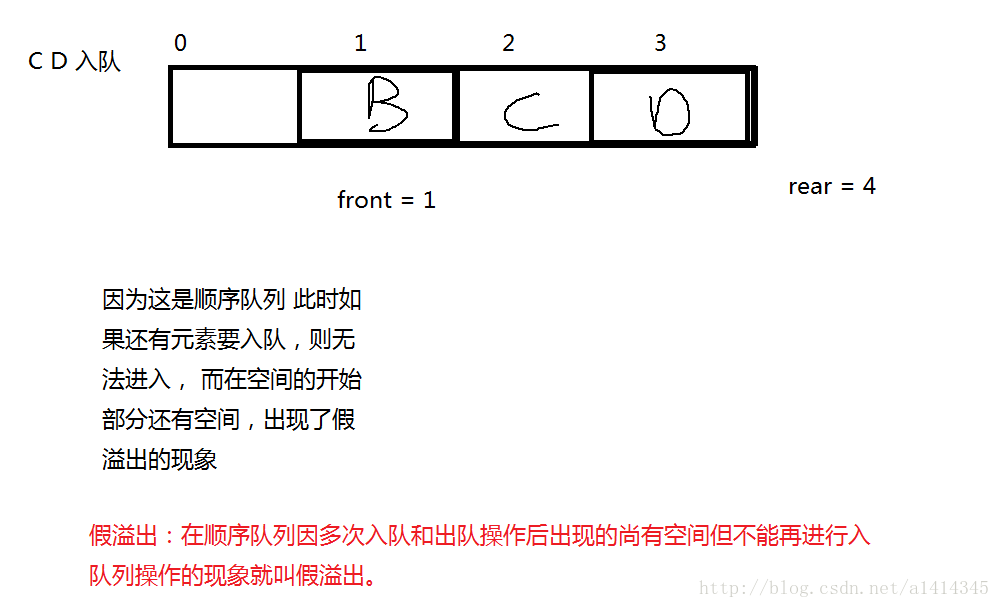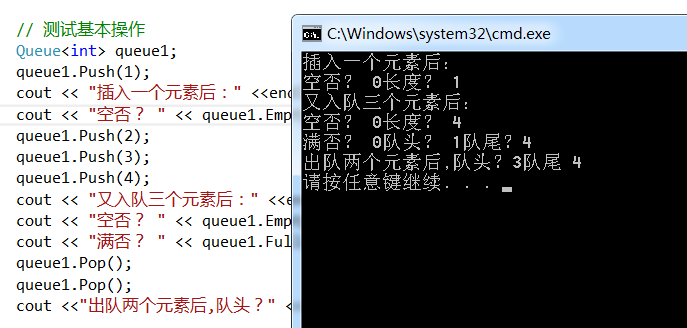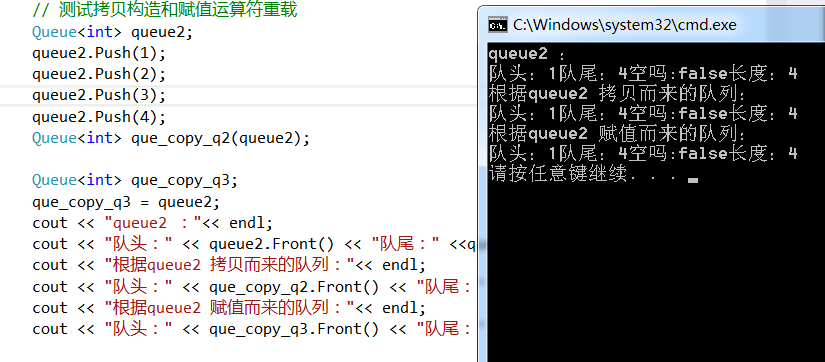-

编程语言
站-
热门城市 全国站>
-
其他省市
-
-

 400-636-0069
400-636-0069
 Vivian
2018-06-19
来源 :
阅读 1101
评论 0
Vivian
2018-06-19
来源 :
阅读 1101
评论 0
摘要:本文主要向大家介绍了C++语言模拟实现顺序队列方法,通过具体的实例让大家了解,希望对大家学习C++语言有所帮助。
本文主要向大家介绍了C++语言模拟实现顺序队列方法,通过具体的实例让大家了解,希望对大家学习C++语言有所帮助。
这是模拟实现顺序队列的第一种方法。
就是入队时队尾在不断后移,直到满,出队时队头不断后移,直到空。
如下如示例:




代码以及简单测试:
[cpp] view plain copy print?
1. #include <cassert> // assert();
2. #include <iostream>
3. using namespace std;
4.
5. // 头在不断变的顺序队列 (非循环队列)
6. template<typename T>
7. class Queue
8. {
9.
10. public:
11. // 构造函数
12. Queue(const size_t capacity = 10)
13. :_rear(0)
14. ,_front(0)
15. ,_capacity(capacity)
16. {
17. _capacity = (_capacity >= 10) ? _capacity : 10; //最少分配十个元素的空间
18. _array = new T[_capacity];
19. }
20.
21. // 拷贝构造
22. Queue(const Queue<T>& queue)
23. {
24. _Copying(queue);
25. }
26.
27. // 赋值运算符重载
28. Queue<T>& operator=(const Queue<T>& queue)
29. {
30. if (this != &queue)
31. {
32. Queue tempQueue(queue);
33. _Copying(tempQueue);
34. }
35. return *this;
36. }
37.
38. // 入队
39. void Push(const T&data)
40. {
41. assert(!Full());
42. _array[_rear++] = data;
43. }
44.
45. // 出队
46. void Pop()
47. {
48. assert( !Empty() );
49. _front++;
50. }
51.
52. // 队头
53. T& Front()
54. {
55. assert(!Empty());
56. return _array[_front];
57. }
58.
59. const T& Front()const
60. {
61. assert(!Empty());
62. return _array[_front];
63. }
64.
65. // 队尾
66. T& Back()
67. {
68. assert(!<span style="font-family:Arial, Helvetica, sans-serif;">Empty</span>());
69. return _array[_rear-1];
70. }
71.
72. const T& Back()const
73. {
74. assert(!Empty());
75. return _array[_rear-1];
76. }
77.
78. // 当前队列中元素个数
79. size_t Length()const
80. {
81. return _rear - _front;
82. }
83.
84. // 析构函数
85. ~Queue()
86. {
87. if (NULL != _array )
88. {
89. delete[] _array; _array = NULL;
90. _front = 0;
91. _rear = 0;
92. _capacity = 0;
93. }
94. }
95.
96. // 判断是否满
97. bool Full()const
98. {
99. return _rear == _capacity;
100. }
101.
102. // 判断是否为空
103. bool Empty()const
104. {
105. return 0 == _rear; _capacity;
106. }
107.
108. private:
109. // 赋值和拷贝构造 调用
110. void _Copying(const Queue<T>& queue)
111. {
112. _array = new T[queue._capacity];
113. _rear = queue._rear;
114. _capacity = queue._capacity;
115. _front = queue._front;
116.
117. for (size_t idx = _front; idx < _rear; ++idx )
118. {
119. _array[idx] = queue._array[idx];
120. }
121. }
122. private:
123. T* _array; // 指向数据的数组
124. size_t _rear; // 队尾
125. size_t _front; // 对头
126. size_t _capacity; // 队列容量
127. };
128.
129.
130. // 测试
131. void Test1()
132. {
133. // 测试基本操作
134. Queue<int> queue1;
135. queue1.Push(1);
136. cout << "插入一个元素后:" <<endl;
137. cout << "空否? " << queue1.Empty() << "长度? " << queue1.Length() << endl;
138. queue1.Push(2);
139. queue1.Push(3);
140. queue1.Push(4);
141. cout << "又入队三个元素后:" <<endl;
142. cout << "空否? " << queue1.Empty() << "长度? " << queue1.Length() << endl;
143. cout << "满否? " << queue1.Full() << "队头? " << queue1.Front() << "队尾?" << queue1.Back() <<endl;
144. queue1.Pop();
145. queue1.Pop();
146. cout <<"出队两个个后,队头?" << queue1.Front() << "队尾 " << queue1.Back() << endl;
147.
148. // 测试拷贝构造和赋值运算符重载
149. // Queue<int> queue2;
150. // queue2.Push(1);
151. // queue2.Push(2);
152. // queue2.Push(3);
153. // queue2.Push(4);
154. // // Queue<int> que_copy_q2(queue2);
155. //
156. // Queue<int> que_copy_q2;
157. // que_copy_q2 = queue2;
158. // cout << "queue2 :"<< endl;
159. // cout << "队头:" << queue2.Front() << "队尾:" <<queue2.Back() << "空吗:" << boolalpha << queue2.Empty() << "长度:" << queue2.Length() <<endl;
160. // cout << "根据queue2 拷贝而来的队列:"<< endl;
161. // cout << "队头:" << que_copy_q2.Front() << "队尾:" <<que_copy_q2.Back() << "空吗:" << boolalpha << que_copy_q2.Empty()<< "长度:" << queue2.Length() <<endl;
162.
163. }
164.
165.
166. int main()
167. {
168. Test1();
169. return 0;
170. }
1.测试基本操作

2.测试拷贝和赋值运算

本文由职坐标整理并发布,了解更多内容,请关注职坐标编程语言C/C+频道!
 喜欢 | 1
喜欢 | 1
 不喜欢 | 0
不喜欢 | 0
您输入的评论内容中包含违禁敏感词
我知道了

请输入正确的手机号码
请输入正确的验证码
您今天的短信下发次数太多了,明天再试试吧!
我们会在第一时间安排职业规划师联系您!
您也可以联系我们的职业规划师咨询:

版权所有 职坐标-一站式IT培训就业服务领导者 沪ICP备13042190号-4
上海海同信息科技有限公司 Copyright ©2015 www.zhizuobiao.com,All Rights Reserved.
 沪公网安备 31011502005948号
沪公网安备 31011502005948号